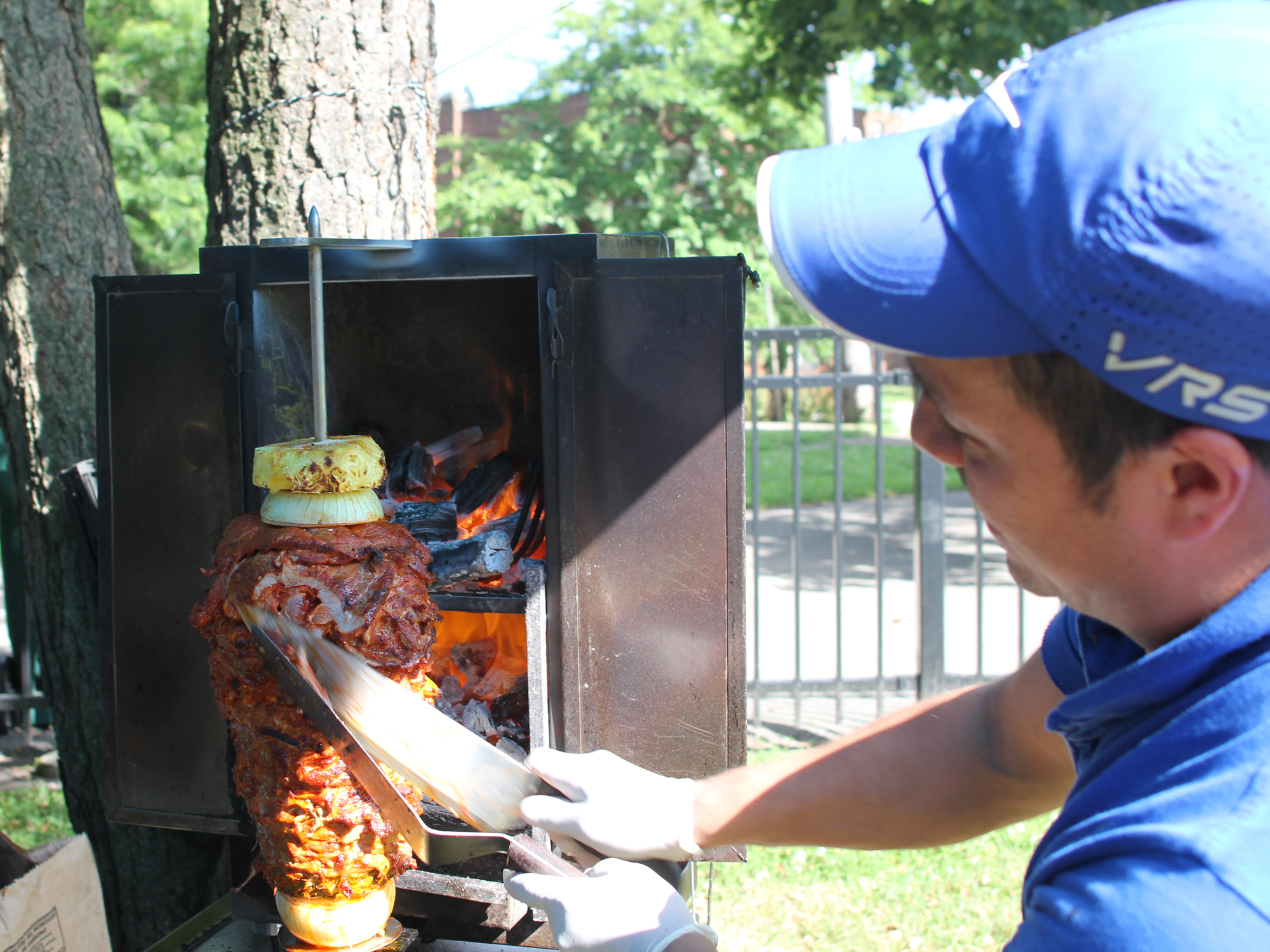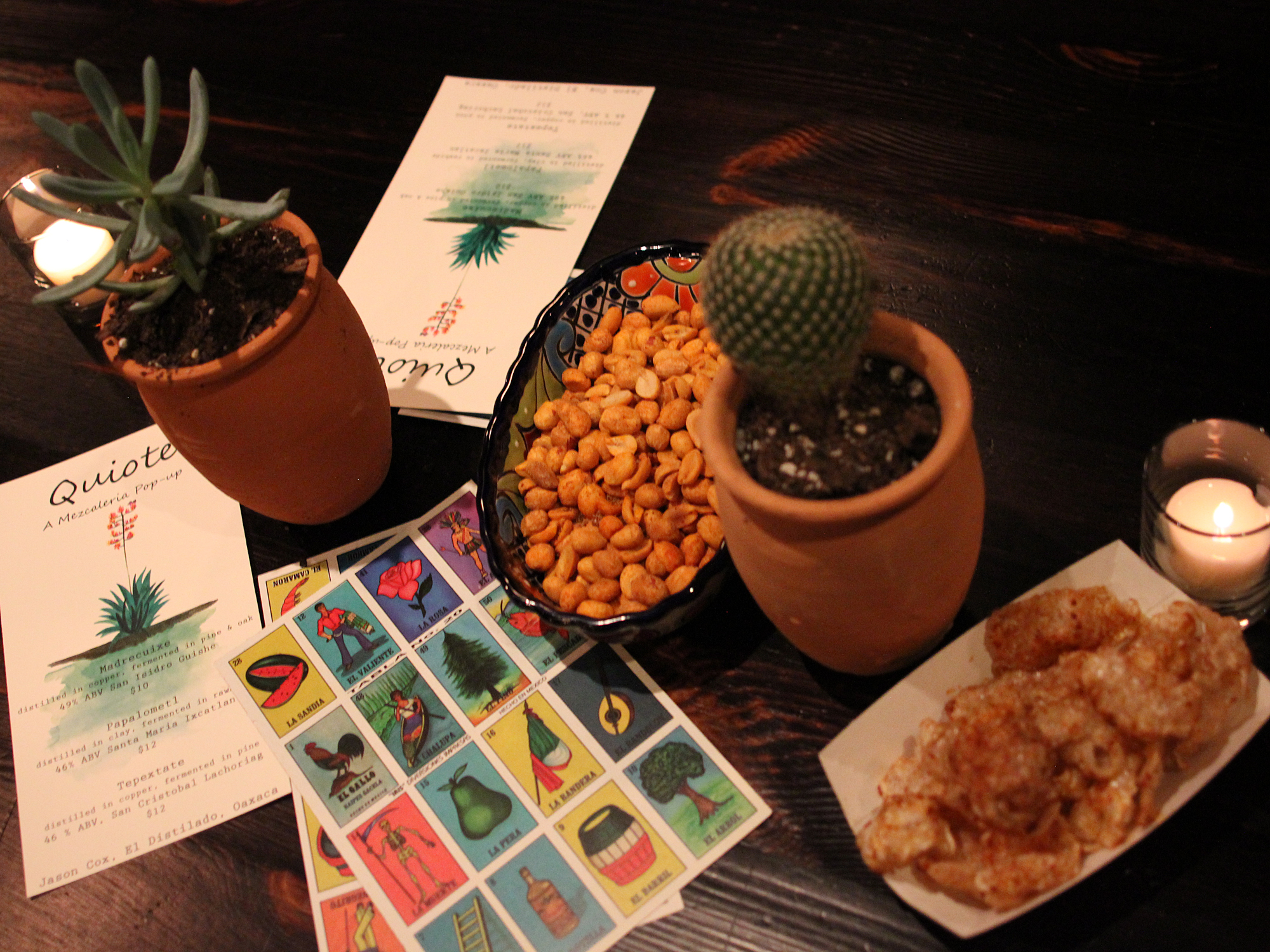BRIAN ENYART SPENT 14 YEARS WORKING FOR RICK BAYLESS; his wife Jennifer Jones Enyart was the pastry chef at Topolobampo until the two of them opened Logan Square’s Dos Urban Cantina late last year. How do you find your own way when you spent so much of your professional development working for one of the chefs who has defined a cuisine in America—who is the way into that cuisine for practically everyone you know?
One answer is to go to the source itself and work on refining your own sensibilities. Brian and Jennifer Enyart did that with their partners in Dos Urban Cantina, Lettuce Entertain You veterans Mike and Erika Rotolo, traveling to Mexico City in July. They came back with some new dishes which they’re highlighting—you’ll see them below—but I also wanted to know about how their own sensibility toward Mexican cuisine has continued to develop, now that they’re working on their own. So I met with them recently and asked them to tell me about their trip, and what they got from it.
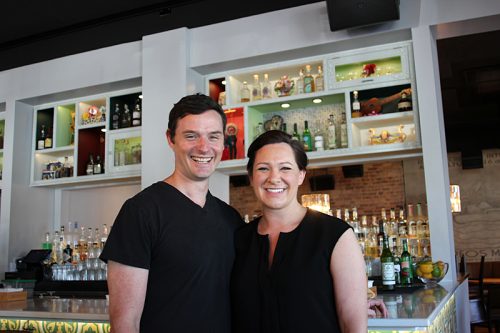
Brian and Jennifer Enyart
BRIAN ENYART: We really wanted to go to Mexico for a couple of reasons, one being that I haven’t been since I left Frontera. I left there in 2011, so I haven’t been since 2010. Jennifer was more recently to Mexico, but still hasn’t been for a while, just because all of our money and time went into this. Our partners, Mike and Erika, have visited Mexico a bunch, but only on the coasts. Never really gotten into the interior of Mexico. And I really wanted to connect with where Mexico is now. And how I engage with Mexico, coming out of the Bayless world and into my own world.
We got to introduce Mike and Erika to the spectrum that Mexico City has to offer. When we opened the restaurant we wanted to do something that was authentic to us, to our experience, and a lot of that is focused on Mexico, but we’re also pulling in a lot of other things that inspired us along the way. We really didn’t have any desire to replicate what we’d done at Frontera/Topolobampo, so this was kind of a nice reset button that lets us see where we fit in the grand scope of Mexican cuisine, and where we are as chefs.
When you say other things that you bring into it, what does that mean?
After Frontera I went to Lettuce Entertain You. They shipped me to California for a while, and I really got inspired by a lot of the food that is out there, a lot of vegetable-based food, a lot of lighter food. I spent some time working at Gjelina, in Venice Beach, to understand Californian vegetable cuisine a little more, and I think that’s played an integral role in creating our lens for how we’re looking Mexican food. We’ve got a very heavy vegetable-based menu—I think it’s very delicious, I’d like to say that—and simple but complex at the same time.
Were you ever tempted to open an Italian restaurant for Lettuce or something like that?
I went to Lettuce specifically because, they are really great at running restaurants. At Frontera and Topolobampo, while we focused a lot on the anthropology of Mexican food, we didn’t focus so much on the business aspect of running a restaurant. And I felt like I needed that, to understand how to open a restaurant and make it successful.
I was with them for a year and a half, and it was time to open up a restaurant with them, and while I had a great time with the company, I didn’t think I could do this concept with them. I had spent a little time at Joe’s Stone Crab, which is where I met Mike Rotolo. When I left Lettuce he reached out and said, what are you doing, and I said I want to open a restaurant, and he said do you know how to do that, and I said, no, not at all [laughs]. So he was kind enough to help mentor us, cobble together the business plan.
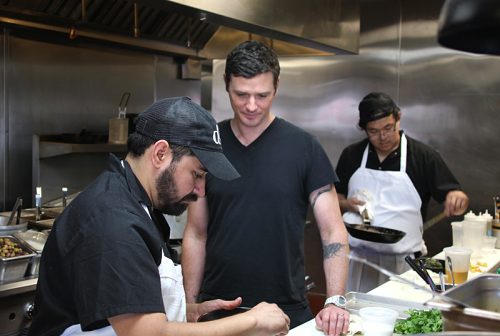
That took about three years, and during part of that time I had a buddy, Freddie Sarkis, reach out to me and say that a friend of his needed help opening a restaurant, El Camino, in Louisville, Kentucky. I consulted for about two weeks, and then they wanted to hire me as the chef. I said, I’m trying to open a restaurant in Chicago, so I’m not moving to Kentucky. So we worked out a deal where I would spend about half the week here and half the week in Kentucky.
When we signed the deal here, Mike and Erika had just finished opening the Joe’s in D.C., and I think they were at a point where they didn’t want to travel as much, and they asked what it would look like if they left Lettuce and partnered with us. Which was super-awesome for us. So that’s how we got here.
What were you doing all this time, Jennifer?
JENNIFER ENYART: Well, I worked at Topolobampo and Frontera up until we were close to this space. I was there for about six and a half years, and I was at Charlie Trotter’s for several years before that. But I’ve always been in love with Mexican cuisine, and getting to know Brian and spending time with Rick at Topolobampo—I loved it. It was very natural for both of us to do Mexican-inspired food, but we have a lot of diverse experience—so there are these things that weave through our food that make it fun and sincere to our experiences.

Zucchini fideos with zucchini “pasta,” huitlacoche, squash blossoms, cotija cheese
Getting back to the Mexico City trip—tell me more about that.
We’ve been open nine months, so it was this opportunity to go down and look for inspiration, and really try to push ourselves forward. We ate a lot of street food; we also went to Pujol, and Quintonil, which are really incredible restaurants, so we really wanted to experience a wide range of Mexican cuisine.
I wrote the menus at Frontera and Topolobampo for almost a decade. That was a lot of me in those menus. And to do something different was very hard.
BRIAN: And also El Cardenal, which neither of us had been to and has been around for a million years. I think it’s really interesting that the traditional food is so amazing, and at the same time they’ve got two restaurants that are on the San Pellegrino top 50 list.
JENNIFER: Our itinerary was really varied, but you never know where inspiration is going to strike. So we really wanted to seek out different experiences.
I know Chef Bayless takes his staff to Mexico regularly, so I assume you’ve both been many times before.
BRIAN: I’ve been to Mexico some 30 or 40 times in my life, and Jennifer’s been a bunch also. We were going about four times a year when I was going with Rick.
What dishes did you add to the menu, based on what you saw and ate on this trip?
We went to La Merced, which is an enormous market, and it’s just flush with activity and people, sights, and sounds. So it was nice to be able to steal a few minutes there and just sit and eat, and it was the first time that Mike had had a squash blossom quesadilla, from tortillas that were just made from a vendor that was making the whole thing right there. And he had this transcendent moment of, like, holy shit this is really good.
It’s also huitlacoche season right now, and huitlacoche and squash blossoms are just really popular together in quesadillas, so we wanted to take that experience and turn it into a vegetarian dish. So we do our zucchini fideos, which is zucchini “noodles,” cooked with huitlacoche and a little bit of queso cotija, which is an aged Mexican cheese, and some garlic, and then topped with squash blossoms, to reinforce all those flavors.

Roasted eggplant with watermelon habanero salsa, pumpkin and sesame seeds
One of the great things about Mexico is the condiments—none of the food is particularly spicy, but the condiments are where you have a lot of fun and a lot of play with that. So we talked a lot about salsas, what is a salsa, what do you do with a salsa, and so we wanted to have fun with that idea. We did an eggplant dish, where it’s roasted very soft, and then we add a watermelon-habanero salsa, kind of playing with the heat and the sweet in the summertime.
We saw some great stuff at Contramar, which is an amazing seafood restaurant in Mexico City. So we’re doing a shrimp ceviche on our special menu, just to highlight really light, really fresh flavors from the sea.
JENNIFER: The dessert that I came back with is a dessert based on an ice cream flavor that is found in every ice cream parlor in Mexico. It’s called Beso de Angel, kiss of the angel—it’s so good. It’s almost like a fruity version of Rocky Road, so it’s like a red fruit base, and then they fold in candied fruits, marshmallows and nuts. So I kind of played with those ideas, and we have an ice cream using berries from Michigan, and then we fold in tart cherries. It’s on top of a walnut crumble, and then toasted marshmallow meringue is on top. It’s a lot of fun.
BRIAN: And we drank a lot of mescal, which is also a lot of fun.
JENNIFER: We’ve gotten in a bunch more mescals, which are on our list, two of which are mescals that we tried in Mexico City.
How has the restaurant evolved since you opened?
BRIAN: Hmm… we’ve only been open nine months, so we’ve really just been trying to understand what people are looking for, kind of how people want to spend their money and how they want their evening to go.
People have been pretty adventurous. There were a couple of things like the raw scallops that I put on the menu for me, I really like eating raw scallops with chiles, but that’s been one of our biggest sellers. And the vegetables have been the biggest surprise. We’re not vegetarian, but we love the diversity that vegetables have to offer, and people have really gotten into our selection of vegetables. Our mushroom dish, grilled mushrooms with the Oaxaca red mole, has been our bestselling dish for many months—
JENNIFER: By double the next dish.
BRIAN: And our vegetable program is just selling way more than our protein is. I’d never have expected that.

Okay, I’ve wanted to ask somebody this for years. You get a plate at an upscale Mexican restaurant, and it’s basically American meat and potatoes—steak in a mole, and potatoes or rice formed into the shape of Chichen-Itza—
Yes! Yes.
It’s a 1950s American meal, basically—and that’s not how Mexicans eat—
That’s true. We do kind of have a plate like that here, but I think we also have tackled these things from a different angle. We said, what do we like to eat, what’s the best way we can serve that, and what are the biggest inspirations that we have. And sometimes those lean on Mexico really hard and sometimes they have other inspirations.
I really love dry aged beef, so we wanted a really savory steak dish. So we kind of built the steak dish around that, and we’re serving it in a pasilla salsa that has black garlic in it, so we’re trying to add all these super-umami flavors to it.
What we really wanted to avoid here with any dish was saying, “How do we make it Mexican?” Or how do we take a Mexican dish and make it more American. We’ve been around the food for so long that it’s kind of second nature for what we think fits really well. But taking those things and trying to “make them Mexican”—that’s just kind of soulless, I think.
Does that force you into small plates, then, though, not making American-style entrees?
I think that what we try to do with the restaurant is things that we really love about restaurants. Like, we love comfortable seating, so we spent the money to make booths. When Mike and Erika and Jennifer were thinking about the wine list, we wanted varietally-correct things that were at a certain price point and were a great value. For the food, we wanted it to be presented in a way that the four of us like to eat. We like to nibble and try a bunch of stuff, so we laid out the menu in the format that it is now.
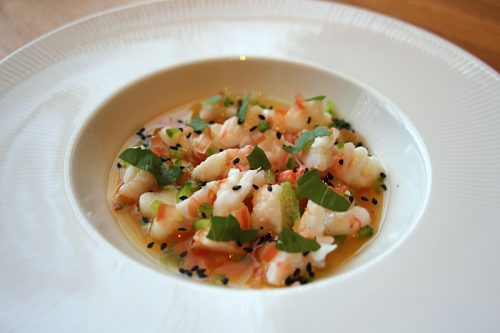
Poached shrimp ceviche with carrot puree, young coconut broth, basil, jalapeño, toasted black sesame seeds
JENNIFER: It’s not like we were trying to do small plates, but we intentionally size our dishes so you can try more than a couple of things.
BRIAN: Anyway, I don’t think Mexico’s too different from any culture where there would be celebratory food, like a big cochinita pibil, but there are also a lot of super-traditional restaurants where you would get a huarache with some skirt steak on it and that would be your meal. But I think that the heart and soul of what is Mexican doesn’t necessarily lie in the protein with accompaniments. It’s kind of the completed dish where the sauce is kind of the king.
And the whole “authentic” thing is an interesting notion to grapple with. Mexico City is almost like a European city, and there are very wealthy Mexicans who will go out and eat at P.F. Chang’s, and that’s not out of the normal. Just because you see it in Mexico, doesn’t make it authentic. We handle that word very delicately, because “authentic” can mean a lot of different things.
JENNIFER: We also talked when we were in Mexico City about how, for the most part, Mexican restaurants [at the high end] are a fairly new thing down there. There are a lot of other cuisines there, but it’s been fairly recent that there have been Mexican restaurants, just because so many people think of Mexican food as their mother’s or grandmother’s cooking.
So you wouldn’t go out as a couple, say, for that?
I think those celebratory meals are often tied to weddings or quinceaneras, where it is so community based. You see places like Quintonil and Pujol now, but that’s fairly recent—
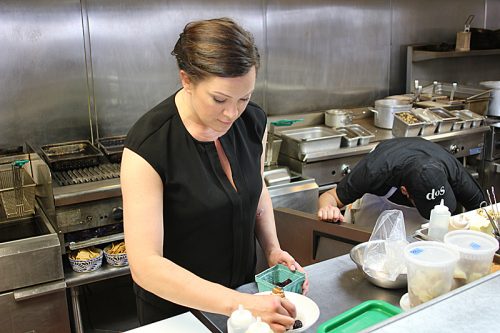
BRIAN: And when Pujol opened about a decade ago, it was literally the first restaurant that was trying to do very high end, Mexican food in Mexico. So that concept is a very new thing. And even Enrique [Olvera, chef of Pujol], who I think came from the Four Seasons—Pujol was very French when it opened.
Well, speaking of influences, let’s go back to yours. How do you find your place in upscale Mexican in a city where the name “Bayless” is attached to that very idea? Especially since both of you were attached to that name for so long.
So long. We collectively have about twenty years of our professional lives with Bayless. I think for me personally as a chef, it was important to find our own identities, which takes a really really long time. Like I said in the beginning, I think where Rick is a really great anthropologist of Mexican food, we had to, for ourselves, when creating things, adhere very strictly to saying it’s Mexican-inspired. And not really go to a specific region in Mexico and say, we love the tlayuda from Oaxaca, so we’re going to recreate that. Because he’s been doing that for maybe 28 years at this point.
We wanted to take the flavors of Mexico, and say, what is near and dear to us? We love Europe, and we’ve been to the east and west coasts, and we’ve cooked in a lot of restaurants. So the only thing that we could do is cook things that make sense to us. We’re trying to make a right when he’s trying to make a left, and be ourselves. And that’s the most authentic way that we could approach making Mexican food, that’s not Bayless food.
JENNIFER: I think what was helpful in part was just the amount of time that we spent trying to get this open. We had a lot of time to develop our menu, and with that time it became more and more ours. Especially when we were doing tastings with Mike and Erika, and it just became very much a personal expression from the four of us.
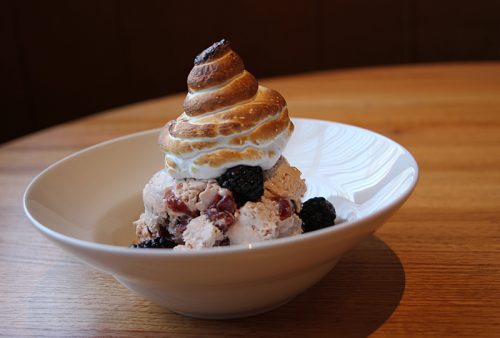
Beso de angel (“kiss of the angel”), fresh berries on walnut crumble, ice cream, toasted marshmallow meringue
BRIAN: But it’s a really great question in the sense that I think I wrote the menus [at Frontera and Topolobampo] for almost a decade. That was a lot of me in those menus. And to do something different was very hard.
JENNIFER: It’s a big transition.
BRIAN: It’s a very big transition. But I think my time away from Frontera, working at other restaurants, really helped kind of reassert what I love about food and how Mexico interplays with that.
What’s something that you’ve done here that’s more you, that you wouldn’t have done at Frontera?
Well, our original carnitas dish, which we’ve changed for the summer, but when we opened it was in the winter and we had kind of a heavier dish on the menu, with a butter potato pupusa and a tomatillo broth. And growing up, we had a ton of potatoes and pork and sauerkraut, because I come from an Eastern European household. So for me, the balance of those flavors and the balance of what I had growing up are very similar, the acids and fats. So that was a natural pairing for me—that I would have never run at Frontera. Because it’s not Mexican. But we’re using Mexican elements, and kind of seeing it through a different lens.
Michael Gebert is editor and el gran calavera of Fooditor.
Latest
Join the Discussion
After you comment, click Post. If you're not already logged in you will be asked to log in or register with Disqus.





